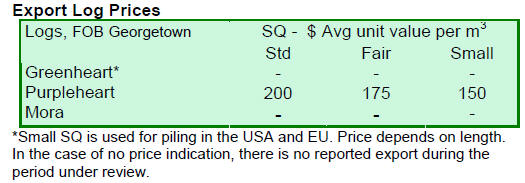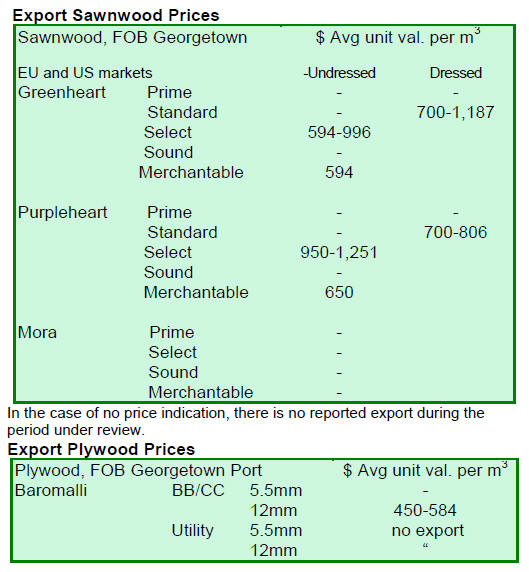2. GHANA
Rules on VPA rules of arbitration and
procedure agreed
Ghana¡¯s Minister of Lands and Natural Resources Alhaji Fuseini has said the
country¡¯s cooperation with the EU and others will continue until illegal
logging and trade in illegally sourced and manufactured wood products is
eliminated.
Mr Alhaji Fuseini made the remarks at a ceremony in
Accra where a new Aide Memoire was signed with the European Union. The
signing of the Aide Memoire took place after the fifth meeting of the Joint
Monitoring Review Mechanism (JMRM) from28-31 May. At this meeting the
discussion centred on mechanisms for supervision and review of the
implementation of the VPA.
The outcome of the JMRM was agreement on the
development of a joint framework to monitor the impact of VPA implementation
and finalise the rules of arbitration and procedure. The agreement on these
issues was included in the Aide Memoire.
Increasing sawnwood availability in the domestic market will help
eliminate illegally cut timber
In another development, the Wood Workers Association of Ghana (WWAG) has
appealed to government to find ways to increase the supply of sawnwood to
the local market to satisfy demand and make it unnecessary for consumers to
have to turn to illegally processed sawnwood.
Ghana has developed policy that seeks to improve the supply of legal timber
demand by the domestic market. Under the policy, sawmills are required to
supply at least 40% of their production to the domestic market but even with
the new policy domestic demand cannot be satisfied.
Providing competitive financing for small and medium sized companies
In a recent press release the African Development Bank (AfDB) reported
approval of a USS 20 million line of credit for UT Bank Ghana to support the
commercial activities of Small and Medium Enterprises (SMEs) and local
corporations.
As the Ghanaian economy continues to grow and
diversify, there is increasing need to address unsatisfied demand for
competitive financing for small and medium sized companies in key economic
sectors such as agriculture and light manufacturing.
This new facility aims to support financial sector development, enhance
regional integration through intra-African trade and contribute to
government revenue generation.
The financing being made available is expected to facilitate trade in
essential raw materials, intermediate and finished goods, and equipment
worth around US$ 140 million.
See:
http://www.afdb.org/en/news-and-events/article/afdb-approves-a-usd-20-million-trade-finance-line-of-credit-for-ut-bank-ghana-to-support-smes-and-local-corporates-11813/
Positive medium term growth forecast for Ghana
The African Development Bank (AfDB) has just released it African Economic
Outlook (AEO) (May 27, 2013) which says Ghana¡¯s economy is expected to grow
a further 8% by end of 2013. The AfDB report also forecast an 8.7% growth of
the Ghanaian economy in 2014.
Ghana¡¯s medium term growth outlook remains positive due largely to
investments in extractives sector industries, public infrastructure and
commercial agriculture.
Ghana¡¯s GDP growth slowed from 14.4% in 2011 to 7.1% in 2012. However, the
report notes that a 7.1% growth, when the world economies were in serious
trouble, was encouraging despite lower cocoa and oil production during the
year.
The AfDB Outlook maintained a focus on the high level of unemployment and
urged the government of Ghana to create the right investment environment to
stimulate growth in labour intensive industries.
See: http://www.afdb.org/en/knowledge/publications/african-economic-outlook/
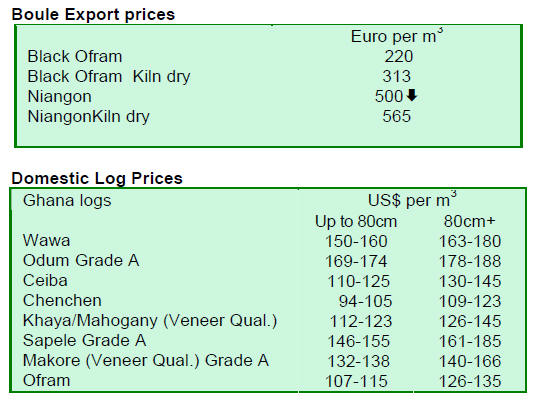
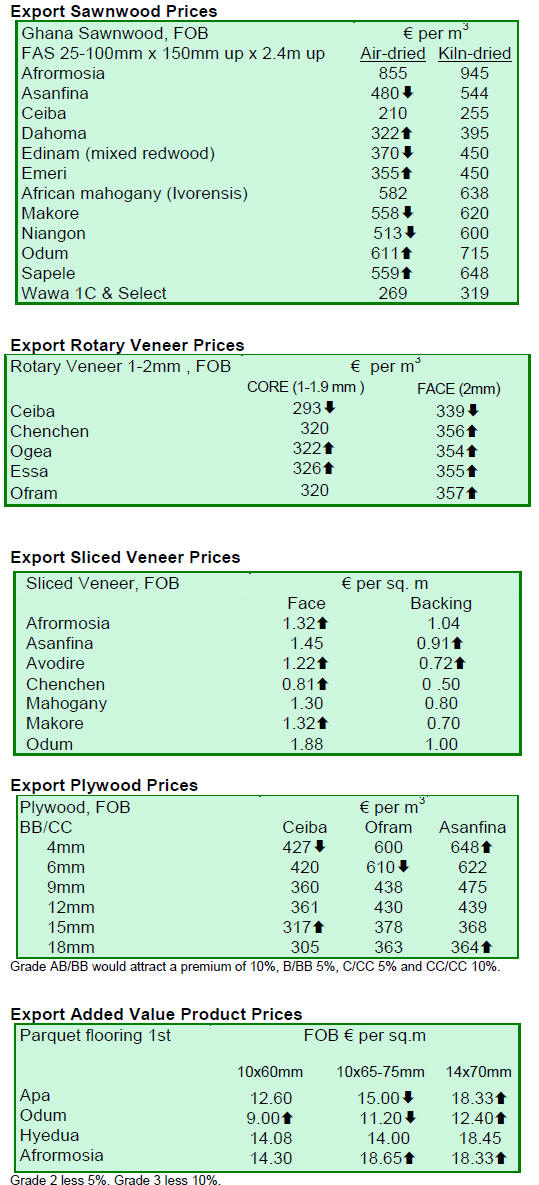
¡¡
3. MALAYSIA
Export demand remains subdued
Analysts report that demand in the main export markets remains weak but that
there are signs of increased buyer interest in Europe and that, after a
quiet spell, Indian buyers have become more active.
First quarter furniture export performance set to be one of the worst in
recent years
The Malaysian Furniture Entrepreneurs Association (MFEA) has said Malaysian
furniture exports fell in the first quarter of this year.
The Star newspaper reported the association president Lor Lean Seng saying
the first quarter performance is one of the worst for the furniture industry
in recent years.
According to a Malaysian External Trade Corporation report, furniture
exports for January and February 2013 amounted to RM1.088 billion (approx.
US$357 million) representing a 9.3% decline from the same period last year.
Exports to the US were worth RM323 million (approx. US$106 million), down 5%
compared to the same period in 2012.
Exports to other major buyers of Malaysian furniture such as Japan,
Australia and United Kingdom also fell in the first two months of 2013.
Japan imported RM119.9 million (approx. US$ 39 million), down 13.7% over the
same period last year while Australia imported 7% less at RM72.9 million
(approx. US$24 million).
Malaysian furniture exports to the UK fell by a massive 23% in the first two
months of the year to RM55.2 million (approx. US$ 18 million).
The MFEA president said the level of orders reported during the second
quarter are not encouraging so export sales are expected to continue to be
on the low side.
Depressing news on furniture sales in the domestic market, where first
quarter business was down 20-30%, is adding to the pessimistic outlook for
the furniture industry.
Malaysian furniture exporters not suffering alone
The president of the MFEA has said furniture exporters in China and Vietnam
are also experiencing difficult times, although Vietnam¡¯s furniture
exporters have an advantage as the dong has not appreciated as much as in
other furniture exporting countries in the region.
The appreciation of the Malaysian ringgit against major currencies has
contributed to the decline in exports.
Peninsular Malaysian exports steady in first two months
Exports of other products by manufacturers located in Peninsular Malaysia
for the period Jan ¨C Feb 2013 were a little more encouraging.
Plywood exports were worth RM839 million (approx. US$ 275 million); sawnwood
exports were worth RM358.7 million (approx. US$ 118 million), and moulding
exports were worth RM125.7 million (approx. US$41 million).
Timber industry vital for continued socio-economic growth in Sarawak
The Borneo Post has reported Awang Tengah Ali, the state minister of
Resource Planning and Environment, saying the timber industry in Sarawak
plays a vital role in contributing to socio-economic growth in the state.
Awang Tengah said the Sarawak timber industry brought in RM7.455 billion
(approx. US$ 2.44 billion) to the state in 2012 compared to RM7.085 billion
(approx. US$ 2.32billion) in 2011. This 5.2% growth was due to strong demand
in markets in the Middle East, South Korea, Singapore, India and
Philippines.
Sarawak timber exports for the first quarter this year totalled RM1.85
billion (approx. US$ 607 million) a drop of 3.2% compared to last year.
The decline was due to an overall decline in demand except in the case of
plywood for which exports increased by 5.4% in the first quarter to RM1.057
billion (approx. US$347 million).
In terms of volume, plywood, which account for 40% of all timber exports by
the state, increased by 14% to 734,162 cu.m.
Sabah reports healthy but not exciting first quarter export performance
The Statistics Department of Sabah released export data for the first
quarter of 2013 showing that sawnwood exports, at 59,486 cu.m, were worth
RM87,2 million (approx. US$28.6 million). Thailand was the biggest buyer of
sawnwood (26%) followed by South Africa (11.9%), Taiwan (11.6%), China
(11.4%), and Japan (9.0%).
Sabah¡¯s exports of plywood for the first quarter totalled 165,205 cu.m
valued at RM 248.6 million (approx. US$81.5 million).
Japan was the main buyer of plywood from Sabah taking an 18% share followed
by Peninsular Malaysia (16%), North Korea (14.6%), Egypt (12.2%) and USA
(8.1%). Veneer exports (8,449 cu.m) from Sabah totalled RM11.8 million
(approx. US$3.9 million) while exports of mouldings totalled RM14.8 million
(approx. US$ 4.8 million). Exports of laminated boards earned RM 18.8
million (approx. US$6.1 million).
4. INDONESIA
Opening new markets the key to boosting
exports
Gusmardi Bustami, Director General of the national export development
division of the Ministry of Trade has said that Indonesian exports are
expected to be higher than last year because of growth in recently developed
new markets.
The ministry official said Indonesian exports could reach US$194-195 billion
in 2013 compared to the US$190 billion recorded in 2012. The ministry is
forecasting that exports to non-traditional markets will increase by around
15% and could earn as much as US$28 billion.
Indonesian exporters have had success in developing markets in Africa, Latin
America and Central Asian countries and efforts are underway to promote
exports in South Africa, Tanzania, Kenya, Nigeria, Madagascar, and
Mozambique.
Until the VPA is ratified Indonesian exports to EU must be accompanied by
evidence of legality
Until the Indonesia and the EU ratify the recently concluded Voluntary
Partnership Agreement, Indonesian wood products entering EU member states
must meet the due diligence requirements of the EU Timber Regulation said
Multi-stakeholder Forestry Program co-director Andy Roby.
Mr. Roby said that, even though Indonesian wood products have been certified
under the national Timber Legality Verification System Certificate (SVLK),
Indonesian exporters still have to provide information on the legality of
the wood products when they are shipped to the EU.
Mr. Roby said only after Indonesia and the EU ratify the Forestry Law
Enforcement, Governance and Trade-Voluntary Partnership Agreement (FLEGT-VPA)
will the EU recognize Indonesia¡¯s SVLK certification as the basis for the
issuance of a FLEGT license.
Exporters of FLEGT licensed wood products will not be required to provide
any further evidence to support the legality of their products.
Ministry of Forestry enlists support to stamp out corruption
The Ministry of Forestry (MoF) recently concluded an agreement with the
Corruption Eradication Commission (KPK) to extend efforts to eliminate
corruption in the forestry sector.
The Minister of Forestry, Zulkifli Hasan said ¡°This effort has been made to
improve the ministry's administration and that the corrupt 'selling' of
concession permits will not be tolerated¡±.
The Secretary-General of MoF, Hadi Daryanto, said further efforts are
necessary as there have been claims that mining and plantation companies are
still involved in corrupt practices.
A recent report has estimated that losses in state revenues from corrupt
practices in the sector were around US$9 million in 2011.
The report identified three patterns of violations in the forestry sector:
operations in protected forests or operations without a concession agreement
from the MoF, undertaking forest-clearance without permission and illegal
logging.
The MoF has said it is overwhelmed with complaints of corruption so needs
the assistance of the KPK to combat corruption complaints.
Plans for forest clearance in Aceh results in public outcry
The Jakarta Post has reported that more than a million people signed a
petition calling for President Susilo Bambang Yudhoyono to block the Aceh
administration¡¯s plan to open protected forests for commercial exploitation.
The petition was begun after changes were proposed to the Aceh planning
bylaw which, say activists, would put the province¡¯s 1.2 million protected
forests at risk from clearing.
The Coalition of Aceh Rainforest Movements, an NGO, has claimed that the new
planning rules could provide for the conversion of a huge part of the 3.5
million hectares of protected forests in Aceh.
However, the Minister of Forestry has said his ministry has only approved
the conversion of 80,000 hectares of forests so that the infrastructure in
the province can be upgraded.
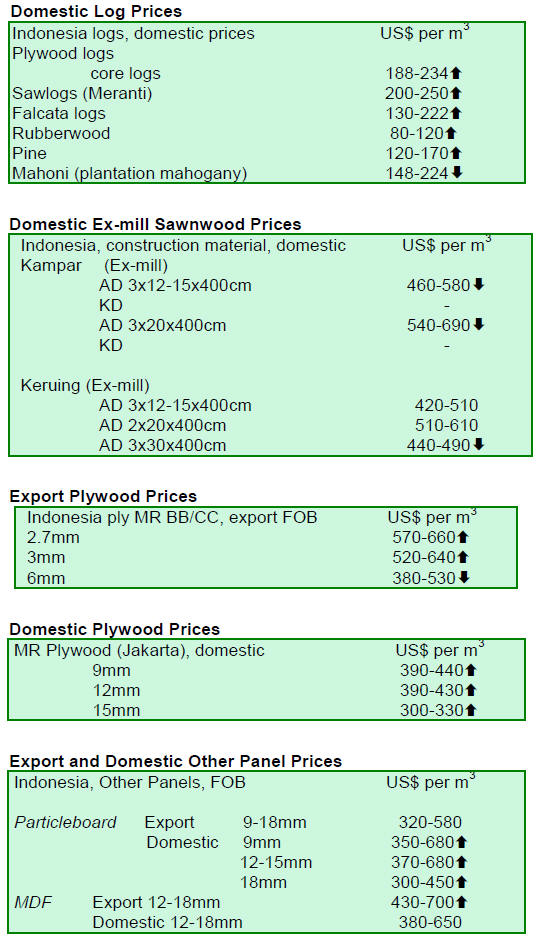

CIFOR spots rare leopard only 100 km from
Jakarta
Researchers from CIFOR have reported sightings of one of the world's most
endangered big cats, the Java leopard (Panthera pardus melas) less than 100
km from Jakarta.
The video footage and photographs released by the CIFOR research project in
Gunung Halimun-Salak National Park show a leopard relaxing in dense forest.
See: http://news.mongabay.com/2013/0521-hance-javan-leopard.html
5. MYANMAR
High log stocks in importing countries
Until this month teak sales were brisk but now some dealers are saying that,
because many buyers have accumulated high levels of stocks, the market for
teak logs is now rather quiet.
Analysts say that buyers in India and Thailand are overstocked with teak
logs and that companies in China can get a steady supply of teak overland
and are not keen to purchase teak logs brought in by sea because of the
addition of shipping freight costs lower profit margins.
During the second half of May teak log shipment were slow and vessels were
waiting for cargo. Analysts say to slow market is partly because buyers had
over extended purchases to increase stocks and that this had created a
financial strain for them.
Analysts do not expect the current situation to persist because buyers are
confident that stocking teak, unlike stocking less durable species, poses
little risk since teak is very durable and can be held in stock for a long
time.
Buyers are anticipating that the value of their teak log stocks will
increase after the log export ban is introduced in April next year.
Timber exports to the EU and the US
The May 17 issue of the domestic newspaper Daily Eleven News reported that,
according to Barber Cho of the Myanmar Timber Merchants Association (MTMA),
Myanmar may be able to start shipping timber that conforms to the EU timber
regulations from 2015.
In the interim the MTMA will publish guidelines to help standardise export
documentation and enable exporters to provide the necessary paperwork
required by importers in the EU and the US to verify the legality of timber
exports.
The MTMA will publish a document 'The Official Compilation of the Export
Documentation in Compliance with the National Rule and Regulation of the
Timber Trade in Myanmar'.
Procedures for clearing export containers to be streamlined
It has been reported that the procedures for
checking export containers of wood products will be streamlined.
At present every container of wood products is inspected twice, once by the
Forest Department when stuffing is complete and again by Customs officials
prior to the loading of the container onto a vessel at the container
terminal.
Exporters have frequently complained that this double check is unnecessary.
News that the Customs inspection at the container terminal will be
eliminated starting June 1, 2013 has been welcomed by the industry.
Under the new system a container inspected and sealed by the Forest
Department and will be cleared for shipping after passing through scanners
at the container terminal. These changes will eliminate delays and expedite
shipments.
Myanmar¡¯s GDP expected to grow
Myanmar's economy expanded 6.5% last year and is
set for further modest growth of 6.75% this year driven mainly by production
and sales of natural gas according to the IMF. The IMF also expects
increases in foreign investment to help narrow the widening current account
deficit.
End May teak auction prices
The following prices were reported from competitive bidding for teak logs on
23rd and 27th May at the most recent Myanma Timber Enterprise tender.
¡¡
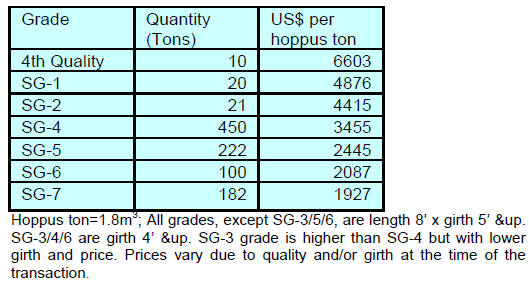
6.
INDIA
Industrial output growth points to
¡®green¡¯ shoots in economy
India¡¯s industrial output climbed 2.5 per cent in March, the fastest pace of
expansion in five months. Rising output has raised hopes that the worst of
the decline in the economy may be over and the slowdown may have bottomed
out.
Official data released in mid May show that March industrial output growth
was up from the 0.5 per cent increase in February however, analysts suggest
interest rates need to be further eased to stimulate industrial activity.
The Reserve Bank of India has so far this year cut interest rates by 0.75
percent in three steps to help revive the economy.
Inflation eases to a 41 month low
Inflation, based on the Wholesale Price Index, eased to 4.89 percent in
April, down from the 5.96% in March and 7.5% in April 2012. This is the
lowest level of inflation since November 2009 when it was 4.78%. The outlook
is that inflation will remain at ¡®comfortable¡¯ levels for next few months.
Exports continue to positive trend
India¡¯s exports, battered by weak international demand for most of last
year, grew by 1.6 per cent in April, the fourth successive monthly growth.
April export figures stood at US$24.16 billion against US$23.70 billion in
the same month last year. However, as the economy shows signs of improvement
imports of gold have increased and oil imports continue to drive the trade
deficit higher.
With an improvement in the US economy and a rise in exports to new markets
such as Latin America, Africa and CIS countries, the Commerce Ministry has
set an export target of US$325 billion for 2013-14 which is about 8 percent
higher than US$300.60 billion in 2012-13.
Mangroves along 720 Km coastline in Maharashtra now protected
The Government of Maharashtra has transferred the responsibility for the
protection of mangroves to a specially constituted unit including the Asst.
Conservator of Forests, Divisional Forest Officers, Forest Rangers and
Forest guards and other stakeholders.
This unit will manage and protect the 18,600 hectares of vulnerable mangrove
forests along the state¡¯s 720 km. coastline.
The mangrove forests have been re-designated as Protected Forests by a High
Court order and all development within the newly protected forest is
forbidden.
Mangrove habitats act as a buffer zone between land and sea protecting the
coast during tsunamis, cyclones and flash floods and also help protecting
coastal erosion.
Expanded farm forestry a win - win for farmers and woodbased panel makers
The wood based panel and paper industries in India have been making progress
in developing dependable and sustainable sources of raw material for their
factories.
Andhra Pradesh Paper Mills Ltd has recently celebrated the planting of the
one billionth tree in their farm forestry initiative.
Similar initiatives on resource establishment have been taken by other paper
companies through successfully convincing farmers to plant superior clones
of eucalyptus and casuarinas on marginal, degraded and unutilized land.
These initiatives are a win - win situation for the farmers and the
industries.
Similar initiatives have been taken by panel industries in northern India
which has encouraged expansion of plantations of poplar and eucalyptus to
meet their requirements for veneer.
However, panel production has expanded so fast that it is outstripping raw
material supplies. Because of the firm demand log prices for panel and pulp
manufactures have increased sharply.
Several panel manufacturers using agri-residues as raw material are also
facing shortages and this is putting expansion plans in jeopardy. Panel
demand has grown by over 25% in recent years but the supply of raw material,
mainly baggase, cannot keep pace.
Baggase raw materials were once priced at around Rs.1000 per ton but now
cost as much as Rs.3000 per ton, all within the span of just two years.
Unfortunately, consumers are not willing to pay higher prices for the
finished products to off-set rising raw material, chemicals and energy
costs.
In addition the industry is facing growing competition , from cheaper
imported alternatives. Government intervention through levying anti-dumping
duties and increased import tariffs on imports of fibreboard, for example,
has not had any significant effect.
Imported plantation teak prices (C&F)
Import shipments of plantation teak have increase by around 5% recently so
there have been some changes in prices however, generally prices are steady.
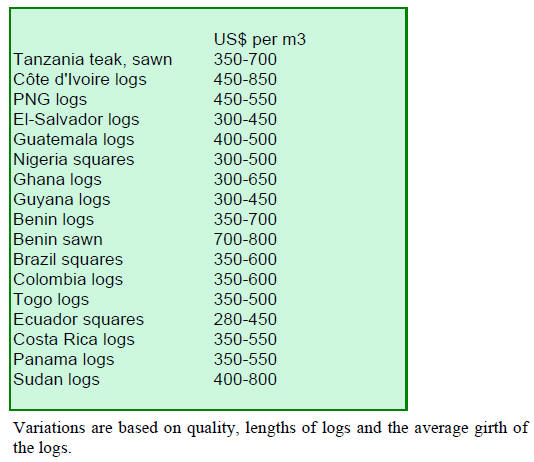
Ex-sawmill prices for imported hardwoods
Domestic prices for air dried sawnwood per cubic foot, ex-sawmill remain
unchanged and are shown below.

Prices for Myanmar Teak processed in India
Despite higher import costs teak prices remain fairly stable. This is
because teak stocks are adequate as importers had steadily accumulated
stocks when prices were favorable and because there is intense price
competition in the Indian teak market. Some price increases are beginning to
be reported and current prices are shown below.

Prices for imported KD 12% sawn wood
The use of imported KD sawnwood is steadily increasing but at the moment
prices remain unchanged as supplies are adequate and there is strong
competition in the domestic market.

Can engineered woodbased panels capture greater
market share?
The total demand for woodbased panels in India is estimated at around 20
million cubic metres out of which plywood accounts for an 80~85 percent
share.
Engineered panels such as particleboard and MDF have not been able to
capture a significant share of the market to change the pattern of
consumption as has happened in other countries.
To expand consumption of engineered panels it is necessary for producers in
Indian to improve the overall quality of their products as end-users such as
carpenter complain about the mechanical properties and water resistance of
domestically manufactured panels. Only when quality improves will engineered
panel makers be able to capture a greater market share.
Plywood market prices
Prices remain unchanged as follows:
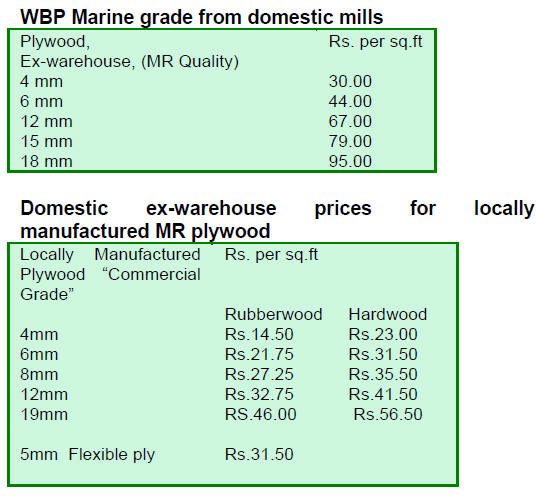
7.
BRAZIL
First interest rate hike since July 2011
Brazil’s Consumer Price Index (IPCA) in April was marginally above the rate
of 0.47% recorded in March. The accumulated change so far this year is
2.50%, significantly up on the 1.87% for the same period in 2012.
In March the average exchange rate of the real to the US dollar was BRL
2.00/US$ compared to BRL1.85/US$ in March 2012, signalling a slight
depreciation of the Brazilian currency.
For the first time since July 2011 the Monetary Policy Committee (Copom) of
the Brazilian Central Bank (CB) raised the prime interest rate (Selic) by
0.25 percent bringing the basic interest rate to an annualized 7.5% per
year.
Low cost chip technology for logging operations
The State Secretariat for the Environment (SEMA) has introduced a new
control mechanism called the “System for Commercialization and Transport of
Forest Products? (SISFLORA 2). The aim is to improve the process of
monitoring and control of production and transport of forest products.
The new system provides the means for greater control to combat
environmental degradation and is based on information chips attached to the
base of trees that will be felled as well as logs that are harvested.
This allows for better digital control of logging activities so that SEMA
will be in a position to monitor log movements through designated chip
codes.
SISFLORA 2 has been introduced to meet international market requirements for
evidence that logs have been legally sourced and to prevent illegally
harvested timber entering the supply chain.
The cost of the chip is almost negligible and a good investment considering
that it will provide the means to certify the legality of logs and wood
products. The major cost centre for enterprises will be management costs
from implementation.
In 2012, SEMA authorized harvesting of 3 million cubic metres of wood. Until
the end of May this year harvesting of some 6-700,000 cubic metres had been
authorized a rate which, if it continues, will result in higher harvests in
2013.
SEMA is discussing the possibility of implementing an improved tracking
system in the first half of 2014. This will provide for better traceability
of forest products commercialised in the state.
New standards for concession audits in State of Amapa
Discussions have been held between the private sector and local governmental
agencies in the State of Amap?as well as representatives from other states
on standards for forest concession allocation in Amapa.
The objective was to establish new rules for concession bidding involving
the State Forestry Institute (IEF) and the State Secretariat of Environment
(SEMA).
It is recognised that forest concession allocations generate direct social
benefits such as creation of jobs, investment in infrastructure and services
to the local community and they add value to a resource and services derived
from natural forests.
The aim of the authorities in Amap?is to minimise the risk of illegal
activities through regular control and audits.
The initial estimate is that the first concession bidding process will
generate around R$ 30 million in terms of civil construction, shipbuilding
and manufacturing and this will generate a revenue of around R$ 5 million
for the state. It is planned that the first concession bidding process will
begin before the end of the year.
The representatives of the Brazilian Forest Service, the Brazilian
Agricultural Research Corporation of Amap? the Secretariat of Rural
Development, Social Inclusion and Mobilization, the State Secretariat for
the Environment, and the Ministry of Industry, Commerce and Mining, and the
Union of Timber Workers of Amap?(Sindmadeira) and community representatives
attended the meeting at which the new proposals were discussed.
Pine sawnwood exports post sharp gains
In April 2013, the value of wood product exports (except pulp and paper)
increased 13.6% compared to values in April 2012, from US$191.4 million to
US$217.4 million.
Pine sawnwood exports fell 12.5% in value in April 2013 compared to April
2012, from US$16.0 million to US$14.0 million. In volume terms exports
dropped 11.9%, from 73,100 cu.m to 64,400 cu.m over the same period.
Tropical sawnwood exports also fell dropping 8.7% in volume, from 28,700
cu.m in April 2012 to 26,200 cu.m in April 2013. The value of tropical
sawnwood exports also declined 8.5% from US$15.3 million to US$14.0 million
in the same period.
Pine plywood exports increased substantially (+20.9%) in value in April 2013
compared to April 2012, from US$30.1 million to US$36.4 million. The volume
of exports also rose 24.9% from 76,800 cu.m to 95,900 cu.m. during the same
period.
April 2013 tropical plywood export volumes remained the same as in April
2012 at 4,100 cu.m.
Exports of Brazilian made wooden furniture rose from US$35.6 million in
April 2012 to US$39.2 million in April 2013, a 10.1% increase.
Project Orchestra Brazil?delivers firm results for furniture exporters
Between January and March 2013, companies participating in the project “Brazil
Orchestra? a partnership between the Union of Furniture Companies of Bento
Gonçalves (Sindmóveis) and the Brazilian Trade and Investment Promotion Agency
Apex-Brazil), recorded a 10.3% increase in exports over the same period last
year.
However, Brazilian exports of accessories, components, chemicals, technology
and design services for the furniture industry dropped 8.3% in the first
quarter and overall Brazilian exports fell 7.7% which signals the success of
the Brazil Orchestra?initiative.
According to Sindmoveis, the good export performance of companies
participating in the ‘Brazil Orchestra?is the result of joint efforts and
strong support of Apex-Brazil.
Currently, more than 100 companies participate in the project. The target
markets in 2013 are Argentina, Colombia, the United States, Mexico,
Paraguay, Peru and Uruguay. In all these countries growth in sales was
reported in the first quarter of the year except in Mexico (-18%). In the
United States, the main export market, exports increased 34%.
After a long period of falling exports to Argentina demand has increased and
was up 8.9% in the first quarter. In addition, purchases by importers in
Colombia and Peru from ‘Brazil Orchestra?participating companies increased
17% and 100.8%, respectively. Furthermore, demand from Chile (+9.8%),
Paraguay (+3.1%) and Uruguay (+9.6%) provided significant growth.
Mato Grosso timber exports hampered by poor road conditions
The revenue generated from forest product exports by companies in Mato
Grosso state dropped 16.4% in the first quarter, compared to the same period
of last year.
According to the Ministry of Development, Industry and Foreign Trade (MDIC)
from January to March 2013, trade amounted to US$22.5 million against
US$26.9 million in the same period last year.
Export volumes in the first three months of 2013 reached 28,127 tonnes,
5.33% above levels in the same period last year (26,702 tonnes).
Exports of sawnwood accounted for the largest shipments totaling 14,235
tonnes, sufficient to generate US$9.5 million. Compared to 2012, there was a
decline of 7.8% in the volume exported and a 16.8% drop in revenue.
According to analysts, exports by the timber sector this year were hampered
by bad road conditions especially in the north of Mato Grosso. From December
2012 to April 2013 export totaled US$80,000 but this figure should have been
in the region of US$ 4-500,000. China is the main export destination for
current production.
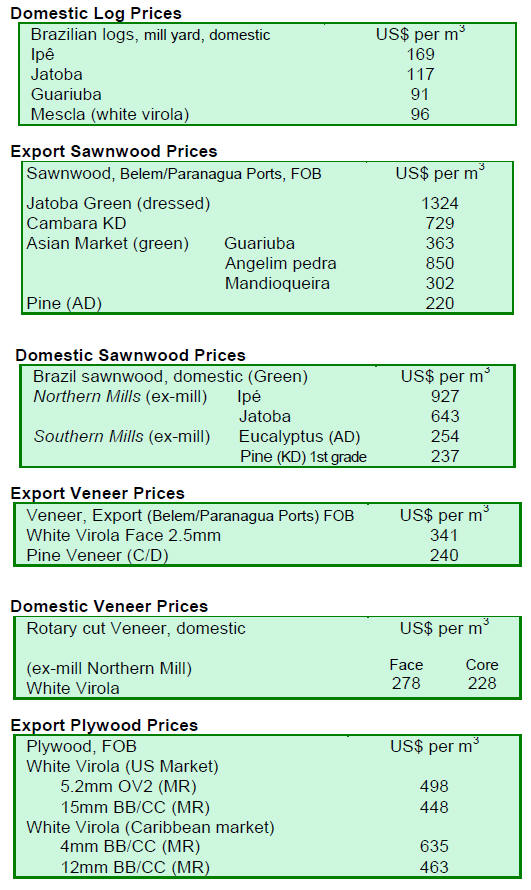
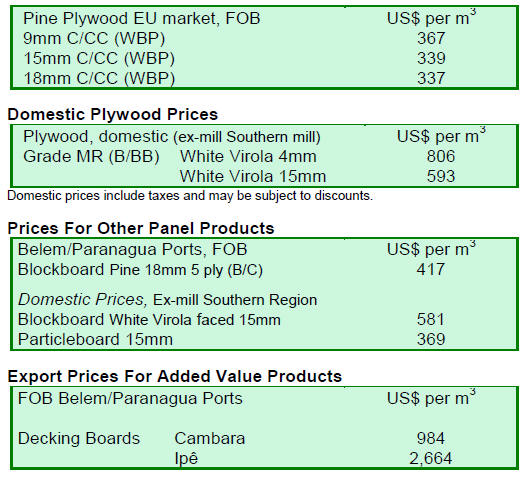
8. PERU
Deforestation, the result of planned
agriculture and illegal intrusions
Gustavo Suarez de Freitas, a forestry expert has reported that most of the
deforestation in the country is the result of a deliberate change in land
use from forest to agriculture.
He has also reported that most of the forest clearance is of small plots of
less than half a hectare for small-scale agriculture and that most of the
clearance is undertaken by immigrants moving into forested areas.
Following on from this assertion de Freitas lamented the failure to better
utilise the extensive forest wealth of the country to alleviate poverty as
well as for economic development.
Adex appeals for re-launch of concession allocations
The Exporters Association (Adex) has called on authorities to re-launch the
Amazon forest concession strategy to provide for expanded development of the
wood processing sector and increased exports. Adex recalled that in 2012
wood product exports declined.
The chairman of the Timber and Wood Industry section of Adex, Erik Fischer,
has said that this request stems from the desire of companies to continue
investing in the sector to improve competitiveness and implement sustainable
projects that have a positive social and environmental impact.
Without a clear direction and a stable policy framework investors are
reluctant to implement long term plans which will consolidated the benefits
from a viable forestry sector in terms of social inclusiveness, wealth
creation and environmental sustainability.
US$7.7 million for forestry development
The Agricultural Bank (Agrobanco) plans to offer US$7.7 million to finance
forestry activities in Madre de Dios, Huanuco, Loreto and Ucayali.
These funds will be allocated to projects for forest rehabilitation and for
forest industry development in areas dominated by the informal timber sector
and where forest degradation from illegal logging is a serious problem.
Agrobanco is the only financial institution in the country to offer a line
of credit for the forest sector.
The bank will consider projects initiatives that promote reforestation with
native species, conservation of forests and wildlife and job creation in
addition to wood product industry development.
To date, the Agrobanco has disbursed loans totalling US$2.7 million to
companies engaged in sawmilling, trading, mining and added value timber
industries.
Some of these funds have been used by entrepreneurs and small scale timber
producers to purchase machinery and equipment that allows them to fully
comply with the recommendations and requirements of the Forest and Wildlife
Act.
The bank also promotes training activities in partnership with public and
private agencies.
New entrepreneurs are offered training in organizational management, market
access and business management. Business management workshops were managed
by timber specialists from ESAN University and the Ministry of Agriculture.
A spokesperson from Agrobanco said the timber sector in Peru has potential
because of the high value commercial species that are available but this
potential can only be released through a process of rational use within the
framework of national and international standards.
The key to releasing the potential of the forestry and wood processing
sectors says Agrobanco is private sector participation in promoting
sustainable forestry development, protection of wildlife and industrial
development.
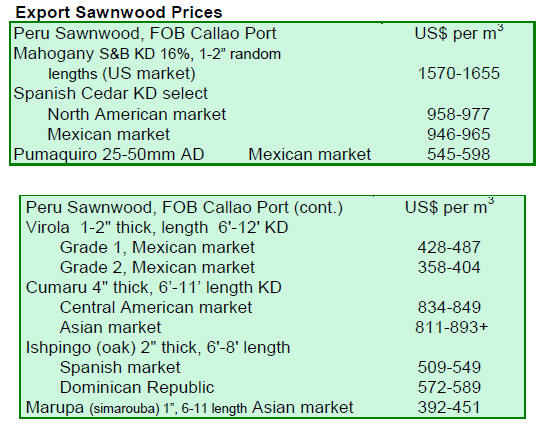

¡¡
9.
GUYANA
Asian buyers seeking newly commercialised
timbers
During the period of review there were few log shipments and none of the
major commercial species, greenheart and mora. Only purpleheart logs were
exported and prices weakened slightly.
However, some of Guyana¡¯s newly commercialized species such as wamara (Swartzia
leiocalycina) and kabukalli (Goupia glabra) were sought after by buyers in
Asian markets.
Sawnwood export earnings compensate for slack log exports
Sawnwood exports made a favourable contribution to export earnings. FOB
prices for Undressed greenheart (select) climbed from US$975 to US$996 per
cubic metre, while Undressed greenheart (merchantable) quality FOB prices
only secured fair prices of US$594 per cubic metre.
Undressed purpleheart FOB top end prices increased to US$1,251 in comparison
to levels in the previous fortnight which stood at US$1,100 per cubic metre.
On the other hand Undressed purpleheart (merchantable) FOB prices only held
on to recent gains. There were no exports of Undressed mora sawnwood during
the period reported.
Dressed greenheart top end FOB prices moved up from US$1,166 to US$1,187 per
cubic metre during the period under review. On the other hand Dressed
purpleheart top end price fell from US$1,102 to US$806 per cubic metre FOB
for this period. Plywood FOB prices were maintained at US$584 per cubic
metre FOB.
Guyana¡¯s wamaradan is French Guiana¡¯s angelique
One of Guyana¡¯s newly commercialized species wamaradan (Dicorynia paraensis),
known as tapaiuna in Brazil and angelique in French Guiana, was traded and
made a favourable contribution to export earnings.
Wamaradan attracted prices as high as US$1,060 per cubic metre FOB in the US
market. This species can be used for building and construction as it is a
very durable timber.
Also, Guyana¡¯s ipe (washiba) was traded at US$2,550 per cubic metre FOB to
buyers in North America.
¡¡
FLEGT support programme launched
FAO, in collaboration with the EU and the Guyana Forestry Commission (GFC),
launched a US$65,000 Forest Law Enforcement Governance and Trade Programme (FLEGT)
support programme which could enable timber traders to expand to new
international markets.
The programme, which is being funded by the EU and implemented through the
FAO, is intended to support an eight month project ¡°Executing Initial
Aspects of the Guyana Roadmap for the EU Forest Law Enforcement Governance
and Trade Programme (FLEGT) Voluntary Partnership Agreement (VPA) through
developing a Communication Strategy and scoping impact of an EU FLEGT VPA
for Guyana¡±.
GFC Commissioner, James Singh, said the negotiations for the programme
concluded last December include plans for dissemination of information to
stakeholders as well as the assessment of impacts which result from the
implementation of the VPA.
FAO Country Representative Dr. Lystra Paul explained that the project is an
important step in helping exporters meet new international requirements.
In 2003 the EU adopted FLEGT Action Plan to address the issue of illegal
timber and prevent such timber entering the EU market. The United States and
Australia also have new regulations affecting the trade.
Guyana¡¯s continued ability to sell to these markets will be determined by
how well its stakeholders address the new market requirements. The FAO
representative mentioned that two companies in Guyana are already able to
satisfy the requirements of the EUTR.
FLEGT roadmap on track in Guyana
The VPA process in Guyana is proceeding according to the timelines
stipulated in the ¡®Roadmap in Guyana¡¯. A technical team from the European
Forest Institute (EFI) visited Guyana with the aim of gaining a better
understanding of the current legality systems within Guyana¡¯s forest sector.
The team was also given the opportunity to interact with the National
Technical Working Group (NTWG) selected at a national workshop to lead the
FLEGT process with the European Union. Representatives of indigenous
Amerindian NGO¡¯s and other stakeholder groups were given the opportunity to
interact with the team.
Launch of communication project
With funding from the EU and with technical support from FAO Guyana has
initiated a project aimed at developing a communication strategy. The
project will also design a scoping impact assessment of the EU FLEGT VPA in
Guyana.
The recent launch of this project was attended by members of the NTWG, the
Ministry of Natural Resources and the Environment, a representative of the
EU and members of the Indigenous NGOs.
The FAO country representative reaffirmed FAO¡¯s commitment to this process
and expressed their appreciation for the manner in which Guyana has executed
FAO projects in the past.
Consultant terms of reference for various elements in the new project have
been published and invitations extended to consultants.
